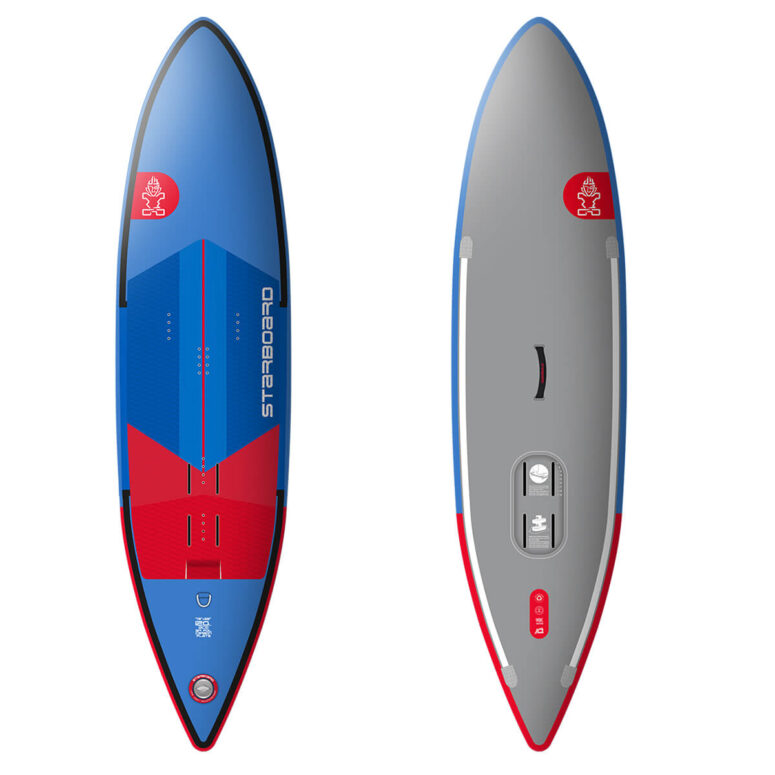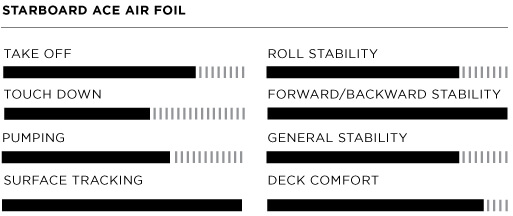

When you purchase gear through links on our site, we may earn a small commission. Here’s why you can trust our tests and our affiliate partner.

Foiling has been a catalyst to develop some innovative products over the last five years, but it’s fair to say we’ve seen most brands align somewhat in their product ranges. Starboard are bucking that trend with the Ace Air Foil and in this instance thinking well and truly out of the box. Two sizes are available with a 120L 7’8 and 100L 6’10.
The versatility of a downwind board cross-discipline is undeniable, but the main negative is their enormous length. No one really wants to travel with a 7ft plus board. Airlines generally don’t appreciate them and they won’t fit in a normal size car without irritating any passengers. Making one from inflatable SUP technology is almost a no brainer, and with Starboard’s long lineage in this medium it’s a perfect fit for the brand.
Shape-wise, it’s a downwind-inspired inflatable form, with draw-out lines, a relatively narrow middle at 23” on our 7’8 test model, and a pin tail which should aid tracking and bump catching.
What we’re presented with is quite a technical feat of mixed materials. The board centers itself around a 1.5cm thick carbon plate, which makes up most of the standing area and includes a twin set of foot strap inserts. In the central section of the board, a raised edge is built into the deckpad, forming a concave and providing you with some reference points to locate your foot position. The rails themselves are welded rather than glued to form a mechanical bond which will extend the life of the board, as seam failure is often what kills an iSUP. Inflation is handled by a single valve in the tail which also contains the leash point for the included coil leash. The rails on the underside of the hull have some plastic edges which sharpen up the normally rounded iSUP rail, aiding water release and planing. The board’s key party piece is the foil box attachment, which is extremely well thought out. Rather than bolt to the bottom surface of the board, the track system allows you to bolt your mast through the top deck which is obviously the rock-solid carbon plate. More or less any T nuts mount upside down to form a robust connection. The void is then filled with a neat foam plug which then makes the bottom of the deck flush.
With the inset mast, there’s two things to consider in this instance – Starboard provide some correct length bolts with pan heads for their system, but if you’re mixing brands you may need to source some and experiment with the thread lengths so that they don’t sit proud of the deck, as this is obviously where you stand. The second caveat is that as the mast is now inset, you’ll lose those first few inches of board, so it may be worth utilizing a slightly longer mast than usual to compensate.
Performance-wise, whilst an inflatable board will never match composite for efficiency, it does a very impressive job. Inflatable wing boards have always been slightly hampered by their lack of hull shape, deck flex and more often than not draggy characteristics. In the case of the Ace, the narrowness eliminates much of this issue. The carbon plate is also a masterstroke, as we know pumping is so essential to wing, SUP and downwind disciplines and being able to transfer energy efficiently into the board and foil. The fact the mast connection sits inset right against that plate gives it a genuinely connected feeling we’ve not previously experienced from an inflatable.
If you were going to take one board traveling with you, space was limited and you were going to encounter mixed conditions, the Ace Air Foil inflatable would be the one to take. It’ll wing in more or less anything, and also paddle capably and is a solid (inflatable) choice.
